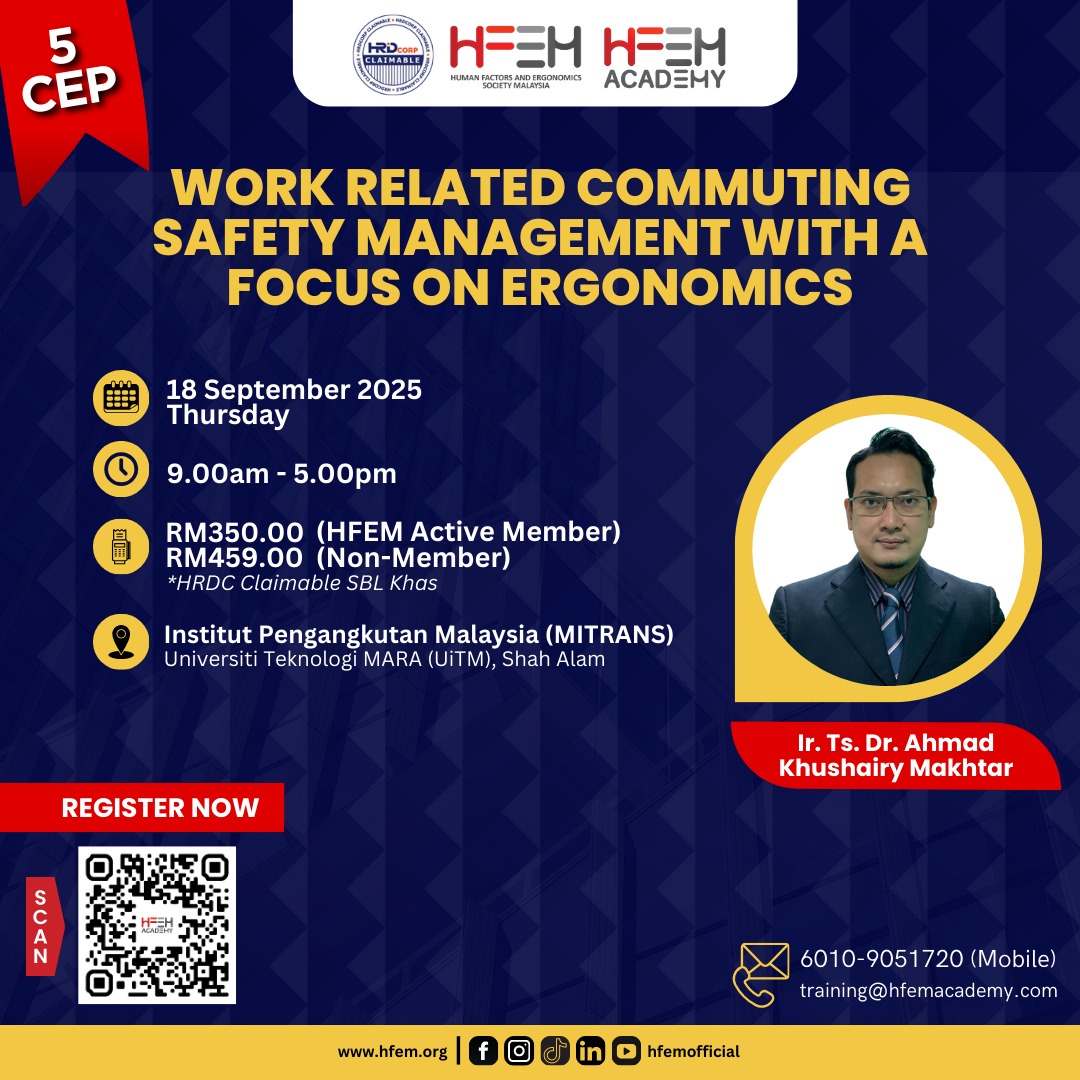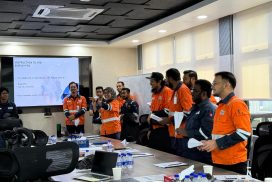Change your browser to Desktop Site format for preferable newsletter layout

HFEM Newsletter | August 2025 | Page 2
Highlight

🇲🇾 Merdeka! Selamat Hari Kebangsaan ke-68 🎉✨
📅 Pada tanggal 31 Ogos, marilah kita bersama-sama menyemarakkan semangat ❤️🇲🇾 cinta akan tanah air dengan penuh kebanggaan dan kesyukuran.
📖 Hari ini bukan sahaja memperingati detik bersejarah kemerdekaan negara, tetapi juga menyatukan kita semua dalam semangat 🤝 perpaduan, keharmonian, dan kemajuan.
🌟 Selaras dengan tema tahun ini — “Malaysia Madani: Rakyat Disantuni”, marilah kita terus bersama membina Malaysia yang lebih 🌱 sejahtera, 🛡️ selamat, dan 🚀 maju.
🎆 Selamat Menyambut Hari Kebangsaan ke-68!
Daripada kami di HFEM & HFEM Academy
#HariKebangsaan 🇲🇾 #MalaysiaMadani 💙

HFEM Expert Talk Series 3 – FREE Webinar!
🚗✨ Work-Related Commuting Safety Management with a Focus on Ergonomics ✨🚦
Did you know commuting accidents are one of the leading contributors to workplace incidents?
This program is designed to help organizations and professionals strengthen commuting safety strategies with ergonomics at the core.
📅 18 September 2025 (Thursday)
🕘 9.00am – 5.00pm
📍 Institut Pengangkutan Malaysia (MITRANS), UiTM Shah Alam
💰 Fee:
RM350.00 (HFEM Active Member)
RM459.00 (Non-Member)
HRDC Claimable (SBL Khas)
🎯 Why You Should Join
✔️ Practical insights on commuting safety management
✔️ Ergonomics-focused strategies to reduce risks
✔️ Earn 5 CEP Points
✔️ Certificate of Attendance provided
✔️ Inclusive of food & refreshments

Connet with HFEM!
📢 HFEM Membership System Upgrade
Dear Members,
We are pleased to inform you that HFEM has upgraded its membership system ✨.
This new system will make it easier for you to manage your membership and stay engaged with HFEM activities.
Membership webpage url: https://membership.hfem.org/index.php
➡️ Step 1: Go to the HFEM membership webpage and click Join Now
➡️ Step 2: Create an account by filling in the required information
➡️ Step 3: After successful registration, please wait for admin approval before you can log in
➡️ Step 4: Purchase your membership product:
🔹 If your membership has expired, upload proof of payment
🔹 If your membership is still valid, upload your previous certificate or any supporting document at the payment area
Not sure about your membership status?
Please email us at 📩 secretary@hfem.org
We are glad to assist you!
Thank you for your cooperation and continued support.
HFEM Secretariat
AUGUST Columnist
From Compliance to Citizenship Behavior
Safety Culture in Transition: Why Now?
In today’s rapidly evolving industrial landscape, occupational safety and health (OSH) has expanded beyond mere compliance with regulations. For Malaysian organizations, it is essential to foster a resilient, engaged, and sustainable workforce. As outlined by the Department of Occupational Safety and Health (DOSH), the focus is shifting from compliance enforcement to a self-regulatory compliance strategy.
Many companies continue to operate with a compliance-driven safety mindset, motivated by rules and the fear of enforcement and penalty. However, imagine a workplace where every employee takes on the extra role of a safety advocate to ensure the safety of themselves and other colleagues. This vision is the foundation for transitioning towards a culture of Safety Citizenship Behavior (SCB).

Leveraging Compliance for Culture-Building
Let’s improve our organization’s safety culture from existing routine compliance activities to a self-motivated and transforming safety culture – SCB. By reframing routine compliance activities as opportunities for participation, ownership, and shared accountability, we can turn mere compliance into catalysts for behavior change.
Start at the Source: Design for Safety
Compliance efforts often begin at the point of enforcement. But culture starts much earlier. From the design phase of equipment, processes, and job roles, companies can integrate inherently safer systems that reduce downstream reliance on enforcement.
o Involve operators in hazard reviews and layout decisions.
o Apply lifecycle thinking to assess risks not just at use, but also during commissioning, maintenance, and decommissioning.
Use Compliance Activities as Behavior Triggers
In Behavior-Based Safety (BBS), behavior is shaped by antecedents (what prompts an action) and consequences (what reinforces it). Compliance tools—like inspections, training, or SOPs—are powerful antecedents when they prompt reflection, discussion, or feedback.
o Convert inspections into learning conversations, not just audits.
o Use investigations not to blame, but to highlight positive behaviors and improvement opportunities.
o Frame refresher training as part of personal growth or team pride.
From Control to Commitment: Engage the Human Element
People rarely commit to safety just because it’s required. They commit because they feel responsible, informed, and valued. This is the turning point between a reactive safety culture and a proactive or generative one.
o Recognize and reward voluntary safety actions (reporting near-misses, mentoring juniors, raising ergonomic risks).
o Build trust through transparent sharing of incident learnings and management follow-up.
o Use compliance data (e.g., noise exposure, chemical use) to spark curiosity and empowerment among workers, not fear.
Align Compliance with Continuous Improvement
Safety systems should evolve just like any business process. Applying PDCA (Plan-Do-Check-Act) and lean principles to compliance helps shift the focus from “Are we following the rule?” to “How can we do this better and safer?”
o Review safety controls regularly as part of Kaizen activities.
o Involve teams in compliance gap reviews, with follow-ups built into departmental action plans.
o Use data (e.g., audit trends, training completion) to drive evidence-based decisions and proactive risk management.
Life Beyond the Policy: Embed Safety into Everyday Identity
Ultimately, compliance is not the goal—it’s the starting point. The goal is to build a workforce that acts safely even when no one is watching. That’s where Safety Citizenship Behavior (SCB) begins.
o Celebrate cross-functional safety improvements (e.g., a technician improving a machine guard design).
o Promote stories of “everyday heroes” who speak up or intervene for safety to motivate SCB development among employees.
o Reinforce the idea that safety is not someone’s job — it’s everyone’s contribution to increase stewardship and help others’ pillars in SCB.
By approaching compliance as a living, evolving system that supports human behavior, Malaysian organizations can unlock the true value of OSH — not just to avoid incidents, but to strengthen resilience, trust, and business excellence from the ground up.
Aligning OSH with Business & ESG Strategy
In today’s highly competitive and sustainability-oriented business landscape, the alignment of Occupational Safety and Health (OSH) with comprehensive business strategies and Environmental, Social, and Governance (ESG) frameworks has evolved from a mere option to a critical strategic necessity. Organizations that recognize safety not just as a regulatory compliance issue but as a key business enabler are poised to significantly enhance their operational resilience, bolster stakeholder confidence, and foster long-term value creation.
The performance of OSH is pivotal in the context of ESG reporting, particularly within the “Social” pillar. This is where organizations can showcase their commitment to employee welfare through various measurable metrics such as lost-time injury frequency rates (LTIFR), which indicate the frequency of workplace injuries resulting in an employee missing work. Additionally, initiatives designed to support mental health and workforce well-being, such as employee assistance programs and wellness activities, play a crucial role in demonstrating a company’s dedication to its workforce. By embedding OSH considerations into enterprise risk management frameworks, organizations ensure that safety-related risks are analyzed and managed with the same rigor applied to financial, operational, or reputational risks. This integrated approach allows decision-makers to adopt a holistic view, leading to informed and effective choices that support overall business objectives.
Moreover, cultivating a strong safety culture within an organization translates directly into enhanced business productivity. Safer work environments reduce the likelihood of accidents and incidents, which leads to less downtime and lower absenteeism rates. Furthermore, improved retention of employees results from a strong emphasis on safety and well-being, which in turn contributes positively to overall financial performance. Leadership accountability plays a vital role in reinforcing this integration of safety into the corporate ethos. By incorporating safety targets into management scorecards and performance reviews, organizations ensure that OSH responsibilities are not siloed but embraced across all organizational levels, from executive leadership to frontline employees.
Beyond internal operations, OSH initiatives also bolster a company’s commitment to human rights and social responsibility. By proactively safeguarding vulnerable workers and promoting inclusive and dignified workplaces, organizations can create a strong social impact. For instance, in the context of supply chains, the safety performance of contractors and vendors can be linked to procurement policies, key performance indicators (KPIs), and objective and key results (OKR). This alignment encourages responsible business practices and ensures that all partners uphold the same high safety standards, thereby solidifying the organization’s reputation.
As businesses face the pressing challenges posed by climate change and evolving environmental risks, many are beginning to recognize the importance of integrating OSH into their climate adaptation and business continuity plans. Protecting workers during extreme weather events—whether it’s providing support during heatwaves, managing safety during haze episodes, or ensuring worker safety in the event of flooding—highlights the proactive nature of OSH strategies. These strategies not only facilitate resilience but also prepare organizations for regulatory compliance amid changing environmental policies. Pursuing recognized certifications, such as ISO 45001, and participating in local safety awards like the NCOSH Awards bolster an organization’s commitment to best practices. These achievements add credibility to the ESG narratives that companies present to investors, regulators, and the general public.
By strategically aligning OSH objectives with overarching business and ESG goals, companies in Malaysia and beyond can elevate the status of safety from a basic compliance requirement to a vital driver of organizational excellence, sustainability, and stakeholder trust. This comprehensive approach not only safeguards employees but also enhances the organization’s reputation and ensures its long-term viability in a rapidly changing world.
The New Direction: OSH as a Strategic Enabler
To remain competitive and credible, companies must see OSH not just as a legal requirement but as a strategic business driver. Let’s move from “have to comply” to “want to contribute.”
Let’s transform OSH from a rulebook into a shared mission.

HUMAN FACTORS AND ERGONOMICS SOCIETY MALAYSIA
Level 3 & 4, Wisma Suria, Jalan Teknokrat 6, Cyber 5, 63000 Cyberjaya, Selangor, Malaysia
Phone: 03-8314 3360 E-mail: secretary@hfem.org




